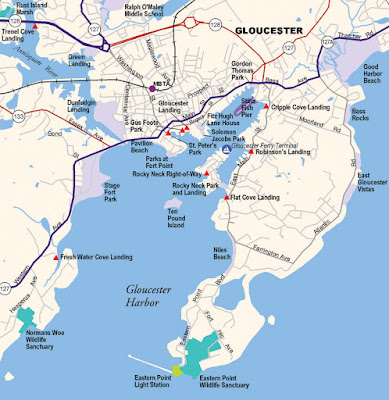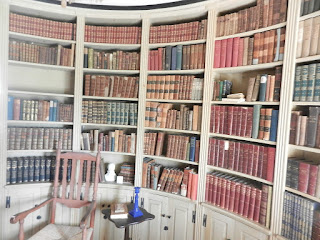Fast forward to 2016 and the trials and tribulations of getting the Caterpillar 1,000 hour performed. We finally found Guy Crudele, a Caterpillar Authorized Marine Dealer who operates out of Gloucester. We agreed to move the boat to Gloucester rather than have him travel to Hingham. This saved us considerable money.
Explanatory Note: Cat dealers charge time and miles for travel to the boat's location. In Crudele's case, he and his assistant would have had to travel 60 miles through Boston traffic each way. That trip is an hour and twenty minutes without consideration for traffic. Throw in Boston rush hour traffic and it could easily be two hours. The 1000 hour service could take as much as three days. Do the math. Two guys at $100/hr times 12 hours plus miles equals well over $2,400. Cruising to Gloucester used less than 60 gallons of diesel ($120). Dockage cost $480 for the entire week. $600 versus $2400.
 |
| Cape May and the Annisquam River |
Important: Hurricane Matthew was turning north just south of Haiti packing winds of 140 MPH. It was predicted to make landfall the following day,
 |
| Approaching the Blynman Bridge at slack tide with a vessel exiting |
 |
| Approaching Cape Ann Marina and Resort |
 |
| Guided Discovery at Cape Ann Marina and Resort |
We chose to explore the the Eastern Point section of Gloucester Harbor. This proved to be a good decision as this represents the "high rent" district with beautiful homes, a yacht club, a historic lighthouse, a historic home (Beauport Sleeper-McCann House) and great walking on roads with no traffic.
 |
| Map of Gloucester |
 |
| Eastern Point Yacht Club |
 |
| View of Eastern Point Light Station from the clubhouse |
 |
| Eastern Point Light Station |
 |
| Beauport Sleeer-McCann House |
56 rooms! We only got to see a few of them on the guided tour. Turns out Henry Sleeper was a prolific collector of antiques who organized his "treasures" in individual rooms, each with a theme. He continued to add additions throughout his ownership of the home to house the stuff he collected. Bottom line. The house was ALWAYS under construction. Here's a few photos of the home.
Adding to the excitement was Hurricane Matthew, which made landfall in Haiti and Cuba as a Category 4 Hurricane and then proceeded north along the east coast wreaking havoc on Georgia and the Carolinas. The eye came ashore in South Carolina on October 8 and then headed north. I had been watching the storm daily since its formation and especially after we headed for Gloucester. The question was would it make it to New England. My prediction, highly influenced by NOAA, is that we had a weather window up until Sunday (October 9).
 |
| Hurricane Matthew approaching the South Carolina |
Explanatory Note: A repair of this nature is somewhat complicated. Essentially, before rebuilding or replacing the coupling, you have to ensure that the running gear is completely sound. This involves hauling the boat to inspect the cutlass bearings that encompass the shaft. Since we had a soft grounding last November off Sarasota I felt it essential to check the bearings and the condition of the propellers. The propellers can be scanned by computerized equipment and any deviation can be corrected. Note: Several divers have checked my propellers and each has reported that there is no visible damage. Once these items are verified, the new coupler can be installed. Then the running gear is checked for alignment. I purchased a replacement unit which is now carried on the boat.
Back to the hurricane. The National Hurricane Center predicted that Matthew would make it to Cape Hatteras and then turn east (i.e., a sharp right turn) into the North Atlantic. NOAA got it right. On Saturday October 9, I cruised single handed back to Hinghan or relatively smooth seas.
We felt the effects of the Matthew as it brushed by well south on Monday with winds gusting to 35 knots.
Written by Les.



















No comments:
Post a Comment